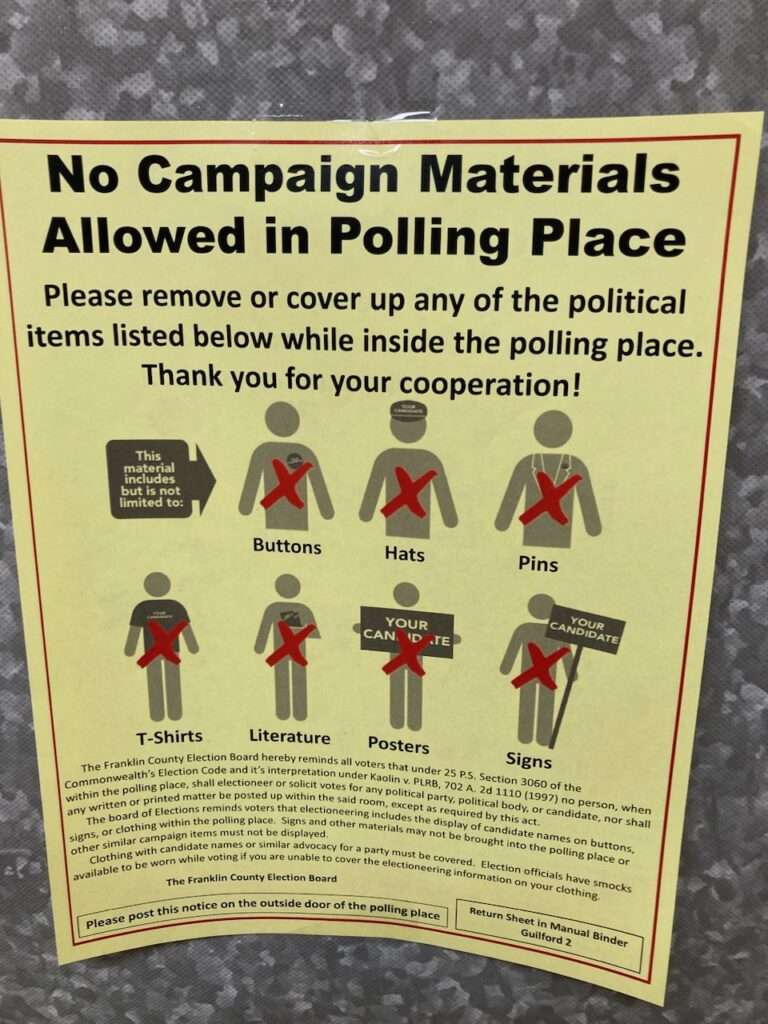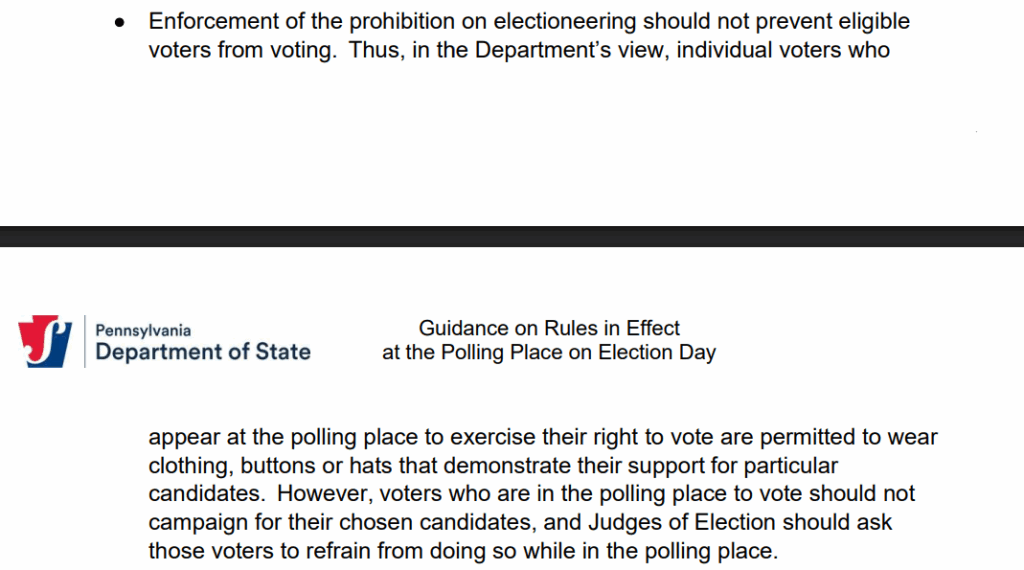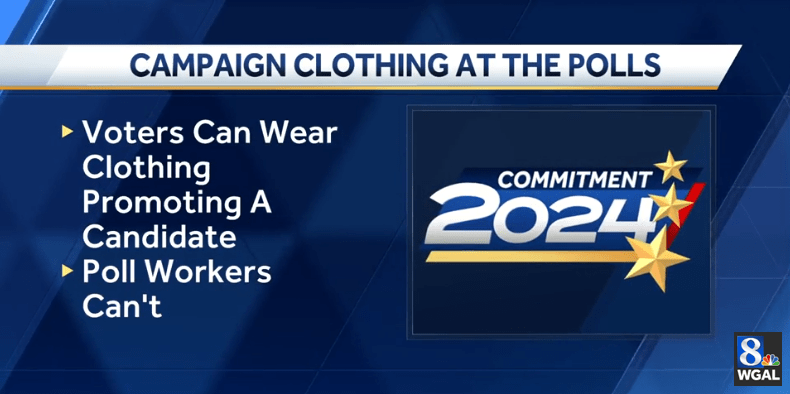Prior to the opening of the polls on November 5th for the 2024 presidential election, Franklin County, PA, election officials prepared the 73 polling locations with required ballots, materials, and signage for the start of voting. The county Elections Board trained poll officials in their mandatory duties and instructed them on preparing the required items and signs at each polling location to facilitate voting.
While county officials prepared polling locations, each major party, Democrats and Republicans, sent poll watchers to the polls and election integrity representatives to the main county canvassing location in Chambersburg. These party representatives were present throughout the day and night to coordinate, observe, and report activities with the PA state and national party election integrity legal teams about any issues concerning voting, the mail-in ballot count, and the collection and counting of ballots from the polls that arrived after they closed.
The Democrat party sourced Bob Ackerman, JD (cum laude Harvard), a Professor of Law Emeritus at Penn State Dickinson Law, and Phil Cosentino, JD (cum laude Dickinson Law), a prominent personal injury attorney in Chambersburg, PA, to conduct election observations. The Republican party appointed volunteers Alex Keely, MSIT JD (candidate with highest honors at Purdue Global Law School (Purdue Law)), a cybersecurity expert and then law student, as Election Integrity Captain for the county, and Karen Brown, the lead Republican county poll watcher and coordinator, to monitor the integrity of election operations.
Around 9 a.m., some Republican poll watchers in the county began reporting to Brown that the county’s election signage, which officials placed outside polling places, indicated a ban on voters from entering if they were wearing political clothing or other items. Brown immediately notified Keely of this development, and they worked to obtain the picture from Republican poll watchers at one of the polling locations, as seen here.

Before this poster was discovered on the walls, there were no reports of problems with this policy. However, Keely raised this issue with the Democrat election integrity team. He indicated that he believed this violated voters’ First Amendment Constitutional rights, specifically their right to wear clothing of their choice as a form of free speech, as long as they were not engaging in campaign or electioneering activities on behalf of a particular party. Keely argued that many people could arrive to vote during lunch and might be turned away if wearing articles with Trump, Harris, or other candidates’ names, and that they might not be able to return to the polls, which could also suppress their votes.

Keely brought up research he reviewed days prior to the election and quoted from the PA Secretary of State’s office in their Guidance on Rules in Effect at the Polling Place on Election Day for 2024, which stated “I]n the Department’s view, individual voters who appear at the polling place to exercise their right to vote are permitted to wear clothing, buttons or hats that demonstrate their support for particular candidates.”
After some initial back-and-forth discussions, the two parties jointly agreed that while polling officials could likely not wear materials displaying their party affiliation, voters should be free to do so at polling locations across the county. While these signs were not outside all polling places, it warranted raising this issue through the national and state Election Integrity teams, and then to the County Commissioners and Election Board. Keely and Ackerman both agreed to go in person to the county Board of Elections to resolve this issue.
Throughout the day, the Franklin County Election Board was open to hearing our concerns. Upon raising the initial issue, staff members expressed some resistance, mentioning that the county’s election materials had been used for decades. The staff indicated that poll officials may not even enforce the ban at the polling place and questioned the validity of the concern. However, after Keely and Ackerman pressed that this was a Constitutional issue that both major parties agreed was a problem that could harm voters, Election Board staff agreed to inform the county solicitor’s office for official legal review.
In the minutes after returning to the canvassing location, Brown informed the Election Integrity teams that reports came in from two Republican poll watchers at polling locations in Greencastle and Chambersburg. Election judges at those polling places would not allow voters to enter wearing clothing with President Trump’s name, and one voter was forced to remove and turn inside-out his Trump 47 t-shirt for the same reason.
Both parties’ Election Integrity teams collaborated to update and coordinate with our state and national legal teams, as well as one of the county’s Election Board managers and Franklin County Commissioner Chair Dean Horst, who were supervising canvassing center operations. Commissioner Horst had already sworn in election workers early that morning and had been visiting polling locations around the county to ensure polling operations were going smoothly.
After returning from his field visits earlier and being informed about the issue and recent developments, Commissioner Horst expressed his concern over the restrictions and wanted to expedite the county’s evaluation of the matter. Shortly after, the Solicitor returned a response, which indicated that the county attorney agreed with Keely and Ackerman’s Constitutional arguments to remove the signs and restore voters’ rights to enter polling places wearing candidate materials.
As a result of their success in defending Franklin County voters’ civil right to wear their campaign gear at polling locations while voting, the county sent messages to all Franklin County election officials to 1) remove the improper signs and 2) not enforce the ban on voters wearing election materials as they voted at a polling locations across the county.
In addition to the initial free speech issue, Ackerman and Cosentino later learned of a similar problem from a local Democrat party candidate handing out partisan materials at a proper distance outside a polling place. Her election materials were being rejected by voters due to the signs banning election materials inside, as well as another election official’s rejection of voters holding campaign materials within the polling location.
Similarly, the parties conferred and agreed, according to the same PA Secretary of State Election guidance, that voters were allowed to hold the election material inside while voting, as long as they did not engage in electioneering activities.

After the issue was raised again through the joint efforts of the election integrity teams, the county responded positively and supported a similar remediation for the second issue related to campaign materials. Following the event, reporters captured a brief segment of the events regarding the free speech issue.

A brief segment summarizing the conclusion of the events aired on WGAL Channel 8 news with anchor Jere Gish. However, it did not contain the details of the hardships that President Trump’s supporters or local Democratic candidates went through regarding their rights to wear campaign gear or distribute voter materials.
The successful outcome of Franklin County voters’ free speech rights was a result of the collaboration, hard work, and key contributions from all parties involved. Republican poll watchers, trained and coordinated by Karen Brown, created the initial notification of the ban. Keely raised the Constitutional rights issues and supported the joint collaborative effort with Ackerman and Cosantino, as representatives from both Democrat and Republican Election Integrity teams, to resolve these First Amendment issues with the county Commissioners and Election Board.
While division along party lines is often the norm, it was a pleasure to be part of bipartisan collaboration on key Constitutional issues in defending voters’ rights to support their chosen candidate without unnecessary and improper government intervention.

